Having friends, whether one best buddy or a group, is important no matter how old you are. Navigating these critical relationships can be challenging at times, especially for young people. The recently published books reviewed in this week’s column explore making and keeping friends as well as highlighting the power of those relationships.
Ages 4–8
Muddle & Mo. Nikki Slade Robinson. 2017. Clarion/Houghton Mifflin Harcourt.
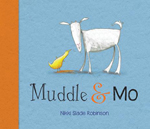 Muddle, a duck, and Mo, a goat, are best friends. The only problem is that Muddle thinks Mo is a duck and is confused by his friend’s un-duck-like characteristics. Muddle finally realizes Mo is, indeed, a goat. After a bit of confusion about whether he is possibly a goat too, Muddle understands they can still be best friends even though they are different. Expressive mixed-media illustrations featuring Muddle and Mo on textured blue paper and minimal text consisting of the dialogue between the two animals make this a fun story with a gentle lesson on identity and friendship.
Muddle, a duck, and Mo, a goat, are best friends. The only problem is that Muddle thinks Mo is a duck and is confused by his friend’s un-duck-like characteristics. Muddle finally realizes Mo is, indeed, a goat. After a bit of confusion about whether he is possibly a goat too, Muddle understands they can still be best friends even though they are different. Expressive mixed-media illustrations featuring Muddle and Mo on textured blue paper and minimal text consisting of the dialogue between the two animals make this a fun story with a gentle lesson on identity and friendship.
Pen Pals. Alexandra Pichard. 2017. Aladdin/Simon & Schuster.
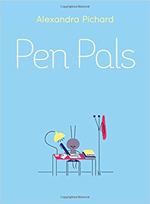 Pen pals Oscar the ant and Bill the octopus love writing and receiving letters and small gifts from each other as they participate in a school project. Despite their differences, they find they have much in common as they correspond with each other by mail. The text consists solely of the letters written by Oscar and Bill. Pichard’s simple digital illustrations—done entirely in red, yellow, blue, and black, and combined with collage—follow the pen pal’s exchange of letters throughout the year. Readers will enjoy identifying the small changes that occur in the repeated scenes of the two friends sitting at their desks penning letters. The depictions of the posting of letters by Oscar and Bill and their delivery by mail carriers, a mouse and a penguin, add to the fun of this story that celebrates the pleasure of sending and receiving handwritten letters through the mail.
Pen pals Oscar the ant and Bill the octopus love writing and receiving letters and small gifts from each other as they participate in a school project. Despite their differences, they find they have much in common as they correspond with each other by mail. The text consists solely of the letters written by Oscar and Bill. Pichard’s simple digital illustrations—done entirely in red, yellow, blue, and black, and combined with collage—follow the pen pal’s exchange of letters throughout the year. Readers will enjoy identifying the small changes that occur in the repeated scenes of the two friends sitting at their desks penning letters. The depictions of the posting of letters by Oscar and Bill and their delivery by mail carriers, a mouse and a penguin, add to the fun of this story that celebrates the pleasure of sending and receiving handwritten letters through the mail.
Ages 9–11
Stef Soto, Taco Queen. Jennifer Torres. 2017. Houghton Mifflin Harcourt.
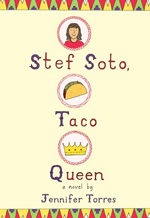 Estefania “Stef” Soto has a love/hate relationship with her family’s taco truck business. On the one hand, she is proud of her father for the hard work he has put into starting his own business; on the other hand, Stef is reminded every day by her seventh-grade peers that she smells like tacos and is even nicknamed “The Taco Queen” by her former friend Julia. Stef is thinking it might just be time for her father and Tia Perla, the taco truck, to retire. Then Stef finds herself faced with two conflicts: her art class needs to figure out a way to raise money for new supplies to carry them through the school year and the city food-truck vendors find themselves faced with a possible shutdown due to new regulations. She must search deep within herself to figure out how she can help find a solution to both issues. Told with Spanish words and phrases integrated into the text, this is a heartwarming story of friendship, family, and food.
Estefania “Stef” Soto has a love/hate relationship with her family’s taco truck business. On the one hand, she is proud of her father for the hard work he has put into starting his own business; on the other hand, Stef is reminded every day by her seventh-grade peers that she smells like tacos and is even nicknamed “The Taco Queen” by her former friend Julia. Stef is thinking it might just be time for her father and Tia Perla, the taco truck, to retire. Then Stef finds herself faced with two conflicts: her art class needs to figure out a way to raise money for new supplies to carry them through the school year and the city food-truck vendors find themselves faced with a possible shutdown due to new regulations. She must search deep within herself to figure out how she can help find a solution to both issues. Told with Spanish words and phrases integrated into the text, this is a heartwarming story of friendship, family, and food.
The Trouble With Friends (The Nora Notebooks #3). Claudia Mills. Ill. Katie Kath. 2017. Alfred A. Knopf/Random House.
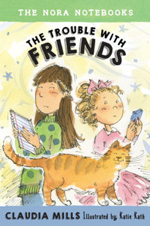 Fourth-grader Nora Alpers loves ants, science, and writing in her notebook. She does not like to try new things. So, when Coach Joe, her fourth-grade teacher, presents the students with “newness challenge,” Nora is skeptical about participating. And when she begins to suspect that classmate Emma’s newfound interest in becoming her friend means that she is Emma’s challenge, she isn’t sure she wants to be the center of Emma’s project. As the story unfolds in the short chapters of this last book in Mills’ series about budding scientist Nora, Nora discovers that trying new things—and making new friends—can be fun.
Fourth-grader Nora Alpers loves ants, science, and writing in her notebook. She does not like to try new things. So, when Coach Joe, her fourth-grade teacher, presents the students with “newness challenge,” Nora is skeptical about participating. And when she begins to suspect that classmate Emma’s newfound interest in becoming her friend means that she is Emma’s challenge, she isn’t sure she wants to be the center of Emma’s project. As the story unfolds in the short chapters of this last book in Mills’ series about budding scientist Nora, Nora discovers that trying new things—and making new friends—can be fun.
Ages 12–14
Posted. John David Anderson. 2017. Walden Pond/HarperCollins.
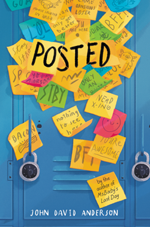 Middle school is a tricky time for friendships, and finding your “tribe” is an important part of a middle-school student’s identity. This is the case for Frost, Deedee, Wolf, and Bench, four boys who find their group identity challenged when the new girl at school, Rose, sits at their lunch table, causing a shift in their relationship. Anderson’s coming-of-age novel captures the angst of middle school friendships as well as both the hurtful and the healing power of words when a sticky-note war erupts after the principal bans the use of cell phones in the school.
Middle school is a tricky time for friendships, and finding your “tribe” is an important part of a middle-school student’s identity. This is the case for Frost, Deedee, Wolf, and Bench, four boys who find their group identity challenged when the new girl at school, Rose, sits at their lunch table, causing a shift in their relationship. Anderson’s coming-of-age novel captures the angst of middle school friendships as well as both the hurtful and the healing power of words when a sticky-note war erupts after the principal bans the use of cell phones in the school.
Velocity. Chris Wooding. 2017. Scholastic.
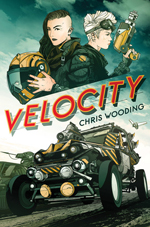 Get your engines revved up for this high-speed, futuristic novel that features two best friends and fearless car-racing power team Cassica and Shiara, who are discovered after they win a race in their small hometown. The girls are quickly brought into the world of Maximum Racing star-power, but they are unprepared for the treachery and corrupt world in which they find themselves. With their sights set on winning the Widowmaker race, with its coveted prize of a lifetime free of care and worry as a Celestial, Cassica and Shiara must decide if winning the race is worth dying—or killing—for. Fans of The Hunger Games and NASCAR racing will enjoy this dystopian adventure.
Get your engines revved up for this high-speed, futuristic novel that features two best friends and fearless car-racing power team Cassica and Shiara, who are discovered after they win a race in their small hometown. The girls are quickly brought into the world of Maximum Racing star-power, but they are unprepared for the treachery and corrupt world in which they find themselves. With their sights set on winning the Widowmaker race, with its coveted prize of a lifetime free of care and worry as a Celestial, Cassica and Shiara must decide if winning the race is worth dying—or killing—for. Fans of The Hunger Games and NASCAR racing will enjoy this dystopian adventure.
Ages 15+
Girl Code: Gaming, Going Viral, and Getting It Done. Andrea Gonzales & Sophie Houser. 2017. HarperCollins.
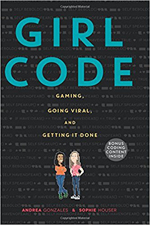 When teens Andrea Gonzales and Sophie Houser met at the Girls Who Code summer program in 2014, they had no idea they would become friends and create a video game that would rocket them into the world of tech phenoms, changing their lives! Girl Code explores the world of coding as well as the limited role that females play in the world of computer programming. In this nonfiction book, told in alternating voices, Andy and Sophie share their journey as high school students thrown together in a world largely dominated by males. Wanting to do something important, they created a video game called Tampon Run, which demystifies menstruation; the game brought them more opportunities than they could ever have imagined. This inspirational dual memoir of determination and perseverance will appeal to teens interested in coding. Back matter includes a Coding Appendix with a glossary and a few basic tutorials for anyone who wants to give coding a try.
When teens Andrea Gonzales and Sophie Houser met at the Girls Who Code summer program in 2014, they had no idea they would become friends and create a video game that would rocket them into the world of tech phenoms, changing their lives! Girl Code explores the world of coding as well as the limited role that females play in the world of computer programming. In this nonfiction book, told in alternating voices, Andy and Sophie share their journey as high school students thrown together in a world largely dominated by males. Wanting to do something important, they created a video game called Tampon Run, which demystifies menstruation; the game brought them more opportunities than they could ever have imagined. This inspirational dual memoir of determination and perseverance will appeal to teens interested in coding. Back matter includes a Coding Appendix with a glossary and a few basic tutorials for anyone who wants to give coding a try.
Goodbye Days. Jeff Zentner. 2017. Crown/Random House.
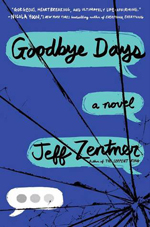 Eli, Mars, Blake, and Carver call themselves the Sauce Crew and are the best of friends at the private arts-focused high school they attend. One evening, as Carver is impatiently waiting for the guys to pick him up after work, he sends Mars a text to see where they are and to tell them to hurry up. And that’s when the terrible accident happens that takes all three of his friends’ lives and leaves Carver alone with his grief and guilt, as well as the possibility of facing criminal charges for sending a text, knowing his friend was most likely driving. This story takes place in the days and months immediately following the accident as Carver embarks on a series of “Goodbye Days” with the other boys’ families and Eli’s girlfriend, Jesmyn. Told in present-day action combined with flashbacks, this novel captures the raw consequences of texting while driving in a way that is both real and meaningful.
Eli, Mars, Blake, and Carver call themselves the Sauce Crew and are the best of friends at the private arts-focused high school they attend. One evening, as Carver is impatiently waiting for the guys to pick him up after work, he sends Mars a text to see where they are and to tell them to hurry up. And that’s when the terrible accident happens that takes all three of his friends’ lives and leaves Carver alone with his grief and guilt, as well as the possibility of facing criminal charges for sending a text, knowing his friend was most likely driving. This story takes place in the days and months immediately following the accident as Carver embarks on a series of “Goodbye Days” with the other boys’ families and Eli’s girlfriend, Jesmyn. Told in present-day action combined with flashbacks, this novel captures the raw consequences of texting while driving in a way that is both real and meaningful.
Jennifer W. Shettel is an associate professor at Millersville University of PA where she teaches undergraduate and graduate course in literacy for preservice and practicing teachers. Prior to joining the faculty at Millersville, she spent 16 years as an elementary classroom teacher and reading specialist in the public schools.
These reviews are submitted by members of the International Literacy Association's Children's Literature and Reading Special Interest Group (CL/R SIG) and are published weekly on Literacy Daily.